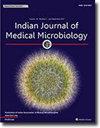Effectiveness of rotavirus vaccine following introduction in the childhood immunization program in Northeast India
IF 1.4
4区 医学
Q4 IMMUNOLOGY
引用次数: 0
Abstract
Background
Rotavirus diarrhoea is a major cause of mortality and morbidity in children under five years of age. The WHO has recommended vaccination against this agent especially in countries with high mortality rates. As India accounts for almost a quarter of worldwide rotaviral diarrhoea cases, the government has introduced indigenously manufactured vaccines in the national immunization schedule which has been implemented in four phases. This study was conducted to assess the effectiveness of the vaccine used in the national immunization program in the state of Manipur in North-east India.
Methods
A test negative study design was used comparing rotavirus positive diarrhoeal children to rotavirus negative diarrhoeal children. All children ≤5 years presenting with acute diarrhoea were enrolled in the study and antigen detection enzyme-immuno assay was done to detect presence of rotavirus. All rotavirus positive patients were taken as cases and compared with rotavirus negative controls.
Results
63 rotavirus positive cases and 121 rotavirus negative controls were enrolled in the study. Vaccination rate among cases was significantly lower than controls (31.7 % vs 68.6 %, p < .001). Vaccine effectiveness of completed vaccination series was found to be 94 % against rotaviral infection and 98.1 % against severe disease and need for hospitalization.
Conclusion
Current rotaviral vaccine used in the national immunization schedule of India is effective in preventing rotaviral diarrhoea in the state of Manipur. Sustained vaccination will reduce the mortality and morbidity of rotaviral diarrhoea in this region.
轮状病毒疫苗在印度东北部引入儿童免疫规划后的有效性。
背景:轮状病毒腹泻是五岁以下儿童死亡和发病的主要原因。世界卫生组织建议,特别是在死亡率高的国家,应接种这种疫苗。由于印度占全球轮状病毒腹泻病例的近四分之一,政府在全国免疫计划中引入了本土生产的疫苗,该计划分四个阶段实施。进行这项研究是为了评估印度东北部曼尼普尔邦国家免疫规划中使用的疫苗的有效性。方法:采用试验阴性研究设计,对轮状病毒阳性腹泻患儿与轮状病毒阴性腹泻患儿进行比较。所有≤5岁急性腹泻患儿均被纳入研究,采用抗原检测酶免疫法检测轮状病毒的存在。将所有轮状病毒阳性患者作为病例,与轮状病毒阴性对照进行比较。结果:纳入轮状病毒阳性病例63例,阴性对照121例。病例接种率显著低于对照组(31.7% vs 68.6%, p < 0.001)。完成的疫苗接种系列对轮状病毒感染的有效性为94%,对严重疾病和需要住院的有效性为98.1%。结论:目前在印度国家免疫计划中使用的轮状病毒疫苗对预防曼尼普尔邦的轮状病毒腹泻有效。持续接种疫苗将降低本区域轮状病毒腹泻的死亡率和发病率。
本文章由计算机程序翻译,如有差异,请以英文原文为准。
求助全文
约1分钟内获得全文
求助全文
来源期刊

Indian Journal of Medical Microbiology
IMMUNOLOGY-
CiteScore
2.20
自引率
0.00%
发文量
154
审稿时长
73 days
期刊介绍:
Manuscripts of high standard in the form of original research, multicentric studies, meta analysis, are accepted. Current reports can be submitted as brief communications. Case reports must include review of current literature, clinical details, outcome and follow up. Letters to the editor must be a comment on or pertain to a manuscript already published in the IJMM or in relation to preliminary communication of a larger study.
Review articles, Special Articles or Guest Editorials are accepted on invitation.
 求助内容:
求助内容: 应助结果提醒方式:
应助结果提醒方式:


